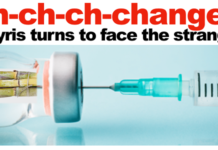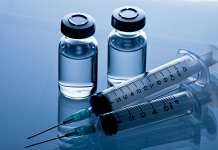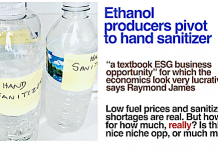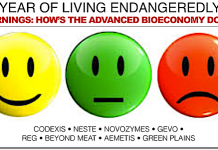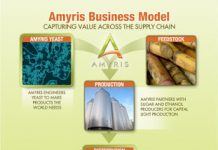Jim Lane
In California, Amyris (AMRS) has a new partner, described fetchingly yet with near-to-complete vagueness as a “a leader in food ingredients and nutraceuticals” which is roughly as helpful as describing a person as “someone who enjoys ice cream”.
Some ice cream there is, nevertheless, in this agreement, which will bring a short-term collaboration investment of $10 million, an equity investment of up to $20 million at $1.40 per share, and $100 million in annual revenue starting in 2017 connected to the production and cost improvement of fermentation molecules. One thing, and the only one, we discover about the identity of this partner, is that they maintain (presumably extensive) industrial fermentation facilities in Asia. The collaboration is subject to completion of definitive agreements and the obtaining of required approvals. Amyris expects this to be completed by the beginning of December 2016.
Striking as this is, let’s make sure that we separate this from the “expanded partnership” announced with a separate global nutraceuticals market leader on September 30, which included the addition of a new nutraceutical target, a credit line of up to $25mm with a five-year maturity, an option for a $5mm strategic investment, and a material expansion in expected revenue.
Kudos, says The Street, but we’ll wait to revise our earnings targets
Of the agreements, Jeffrey Osborne of Cowen & Company wrote: “We are encouraged by these recent announcements which provides visibility into collaboration funding for the next few years in an end market that has historically carried higher margins relative to other end markets in the space. We are leaving our estimates unchanged at this time given the limited amount of details provided in the release. Amyris expects completion of the definitive agreements and to obtain the required approvals for the collaboration by the beginning of December 2016.”
Amyris’ John Melo was in a bullish mood as well. He said, “We’re very pleased with the opportunity to partner with one of the leading nutraceutical and food ingredient suppliers in the world. Our current annual revenue run rate of over $100 million combined with the $100 million of annual revenue we expect from this partnership starting in 2017, should help us deliver stronger than expected growth in 2017 and beyond.”
The Farnesene Bulls are running
By the way, InsiderFinancial.com writes:
“The thing to recognize here is that demand for farnesene is increasing dramatically (analysts expect the market to grow more than 27% CAGR to 2023, from its 2015 levels of 8 kilo tons in 2015) and Amyris is the only company in the world that can produce it the scale required (we could be even stricter here and say it’s the only company that can produce it full stop) to meet this demand.”
If those numbers hold, that’s good news for Amyris, and investors such as Kuraray and Total. But also let’s not overlook Intrexon. Or even Chromatin.
Back in 2014, the lab geniuses of Chromatin announced that it had created sorghum plants containing elevated levels of the energy-rich compound farnesene. The milestone was supported in part by the Department of Energy’s ARPA-E program Plants Engineered To Replace Oil (PETRO). “We have demonstrated that sorghum can be modified to produce significantly elevated quantities of farnesene relative to commercial inbred sorghum lines, a molecule that can be used to create energy-rich biofuel,” said Chromatin CTO Ken Davenport at the time.
Keep a sharp eye on Intrexon
Over on the low-cost feedstock front, keep an eye out for Intrexon. They tipped two summers ago that they had demonstrated bioconversion of methane to farnesene in the lab. This was the second product, following isobutanol, which Intrexon has upgraded from natural gas employing its unique cellular engineering capabilities.
Intrexon is developing microbial cell lines genetically enhanced to convert methane to higher carbon content compounds at ambient temperatures and pressures, thereby reducing the significant expenditures compared to standard gas-to-liquid processes. In theory, you get low capex and you get access to that deliciously low-cost feedstock, our friend methane.
The 8 Rays lighting Amyris’ Golden Lamp
In August, we highlighted 7 rays lighting Amyris’ Golden Lamp, in our story “The New Colossus”, here.
We’ll add the pair of nutraceutical deals and name that Ray #1. The other 7?
#2. Gingko. Entered into an Initial Strategic Partnership Agreement with Ginkgo Bioworks to accelerate commercialization of bio-based ingredients and establish clear leadership in industrial biotechnology with a combined offering that we consider unparalleled. In connection with the agreement, a license fee of $15 million was paid on July 25, 2016, to Amyris in exchange for use of certain Amyris technology and the parties agreed to pursue the negotiation and execution of a definitive partnership agreement that includes significant value sharing. The partnership is expected to deliver more new ingredients into the global market over the next three years than the entire industry has achieved in the last 10 years.
Melo pointed to the company’s DARPA collaboration which has identified 400 different molecules, “all of which we can commercialize at our discretion.” Also, 5th. Additional with Gingko, “we are already collaborating to align R&D and take 70 products to the world’s leading brands.”
Melo said that critical to Amyris growth will be “more capacity” and the Amyris potential to “accelerate products”. Meanwhile, “the Brotas plant is running flat-out with farnesene production”, the North Carolina facility too. The company has plans to double capacity at Brotas and is speaking with potential collaborators about potential expansions to increase capacity for 2017.
#3. Cosmetics and personal care. Announced multi-year, multi-million-dollar collaboration in cosmetic active ingredients with Givaudan to engineer and produce cosmetic active targets for global commercialization by Givaudan. Amyris sees this partnership delivering an annual run rate $50M per year
#4. Fragrance & flavors. Began commercialization of novel fragrance product with Takasago International Corporation. The company said that it had greatly expanded in F&F novel fragrance ingredients, partnered with 4 of the top 5 companies, and is “on track to become one of key suppliers.”
#5. Jet fuel. Jointly announced with Cathay Pacific a two-year biojet agreement supporting continued strong farnesene demand and the future of sustainable air travel; initial flight on May 12, 2016 using the biojet blend was the longest flight using a renewable jet fuel to date. This fuel is supplied through the Amyris Total partnership that is dedicated to making BioJet an industrial reality.
#6. Novvi. Announced American Refining Group’s 33.3% equity investment in Novvi LLC, a joint venture of Amyris and Cosan S.A., enabling market access and acceleration in revenue growth of Novvi’s high performance, sustainably sourced, renewable lubricants.
#7. Janssen. Entered into research agreement with commercial license option with Janssen Biotech, facilitated by Johnson & Johnson Innovation, to use Amyris’s µPharm platform for rapid integrated discovery and production of therapeutic compounds thereby opening a new area of compounds previously not accessible for new drug discovery. “We expect to sign one more collaboration by the end of the year, ending at the high-end of our range, to develop a library of natural and natural like of therapeutic compounds, which nature has the potential to
provide and we have the ability to produce.”
#8. Biogen. Amyris announced a partnership with Biogen, Inc. to develop alternative cell lines supporting production of therapeutics, marking second major partnership in biopharma market, which is now positioned to become Amyris’s largest opportunity for collaborations. The Biogen partnership is the most exciting of all,” CEO John Melo said,. With it, Amyris he said would make “ a transformative change to biopharma where partner would be able to employ [Amyris biotechnology] instead of using cells from mammals. Others have attempted and failed, but we are positioned to deliver life saving therapeutics and make them more widely available. This could be game changing for biopharmaceuticals, and Biogen will fully fund the development.”
Amyris – time to expand capacity?
At some stage Amyris, which is essentially sold out at Brotas, will have to bite the bullet and expand capacity instead of engaging in margin-munching tolling arrangements. We’ll stand by for that.
When will the stock take off?
Two milestones to watch.
1. If Amyris reaches $100 million in revenue for 2016, that’ll be a milestone we’d expect investors to note and re-value the company at. Identifying at least a couple of these nutraceutical partners wouldn’t hurt either. The company says it has hit the $100M “annual revenue run rate” mark, so that day should not be all that far out ahead, assuming that, when the dust has settled, these revenues are coming in at normal margins and don’t represent giveaway deals to sell out the production volume at the plant.
The average price-to-sales revenue ratio on NASDAQ is 3.2. That would put Amyris around the $330M mark in terms of market cap when it hits $100M in revenues and the company is at $183M right now. There’s around $100M in debt on the books, but with the NASDAQ debt/equity average hovering around 0.65, the debt level doesn’t appear to be a drag on share prices.
2. Break-even on operations. Fear of dilutive capital raises appears to be on investors’ minds, especially given the potential need to expand capacity soon. The double whammy of raising money for a second plant and to fund continuing operations from the first plant appears to be a factor. Can Amyris reach cash break-even off the first production plant? We’ll probably know when we reach the end of the year so, somewhere between December and February (when earnings are presumably announced), expect that Amyris investors will substantially and upwardly revise the value of the company, or sigh and settle in for the long-haul of dilutive capital raises until he second plant is constructed and the offtake is sold.
Jim Lane is editor and publisher of Biofuels Digest where this article was originally published. Biofuels Digest is the most widely read Biofuels daily read by 14,000+ organizations. Subscribe here.

